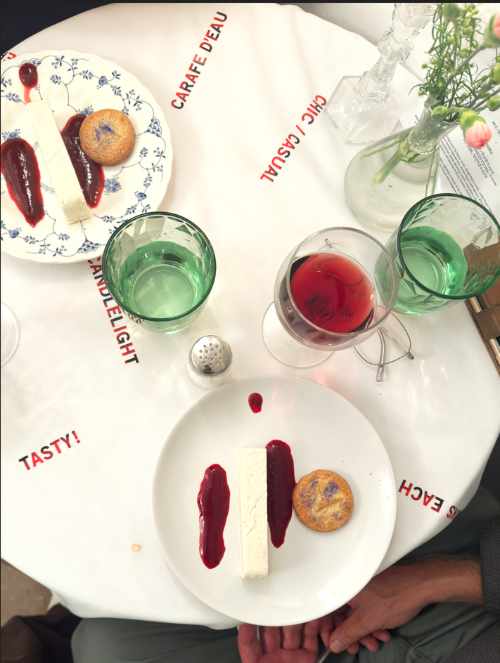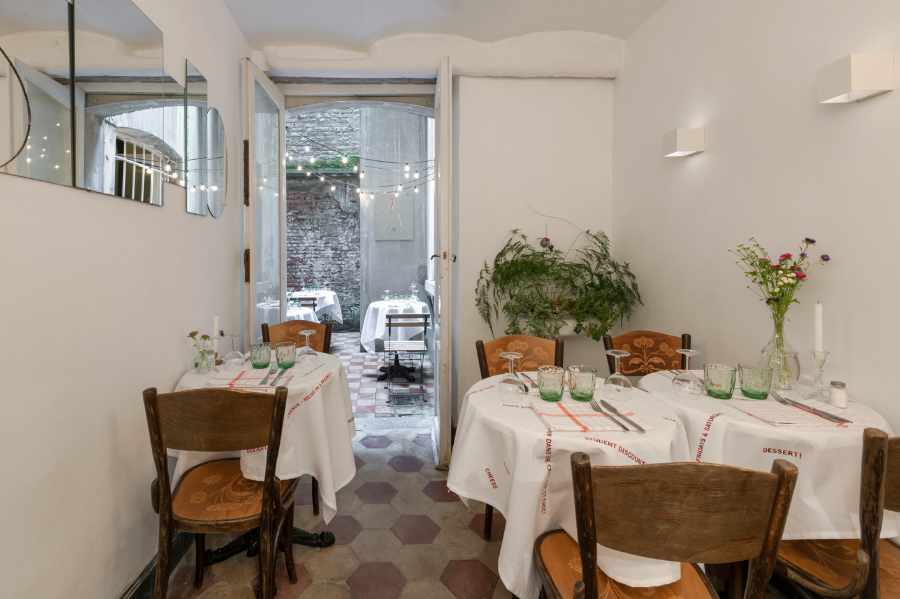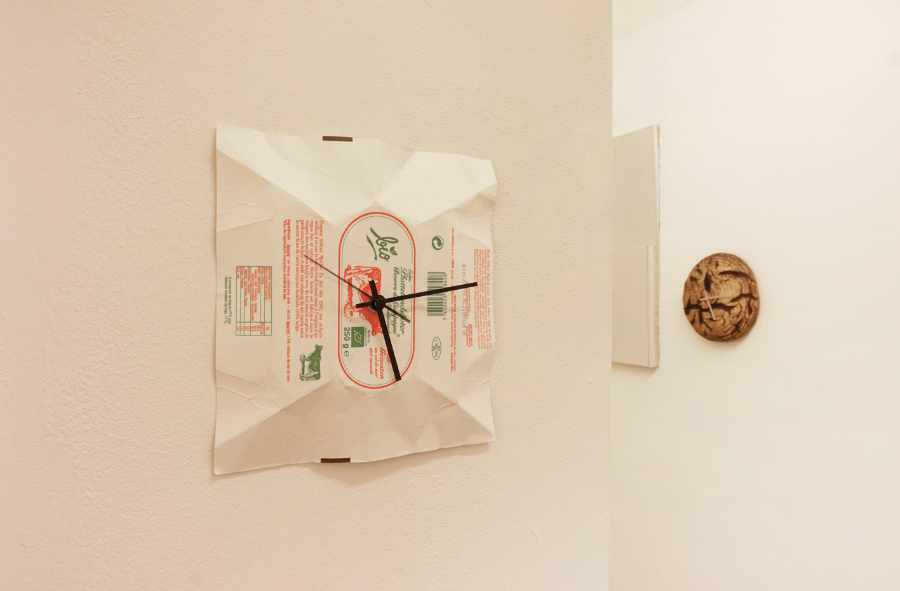Le Bistro
HERMANY
30 August – 14 September01-10-2024
It was a good weekend to hitch a flixbus to Brussels. Anthony Huberman was on a Euro tour, passing through to open the Ana Jotta show at WIELS; there was something happening at The Tail; and I had dinner reservations at Le Bistro, a restaurant open for three weekends at HERMANY, a project space run by artist Marlie Mul. HERMANY cycles through various forms, including exhibitions, fashion events, readings and so forth. HERMANY mirrors Marlie’s own polymorphic practice, which includes running the clothing label PMS, art education, gallerist, and now restaurateur, not to mention sculptor, photographer, etc. Like the sperm that have populated much of her recent work, Marlie’s practice has the ability to embody any number of roles and functions, an openness to the needs of the moment. Some recent sculptures that she exhibited at Gaylord Fine Arts in Los Angeles reminded me of this autopoietic capacity: silicone forms folded in upon themselves sprouting hair, tiny bones and bits of hardware, bodies of pure immanence, like those giant tumors that grow teeth.

HERMANY is in the basement of what was formerly La Maison de Rendez-Vous, a space shared by three galleries based outside of Brussels, and now celador, which states that it is “run collectively by a reading group”. Amidst this rotation, Marlie has remained the steady presence in the building, the quintessential host. Le Bistro invited an artist-chef each weekend to cook a three-course prix fixe in the small basement space for around 15 guests in two shifts. I booked for the deuxième service so I could linger a bit and have a drink with chef George Rippon and Marlie the maitre d’. A small crowd had gathered as we waited for the tables to be reset. The ingoing and outgoing shifts began to mingle: Katja advised us not to fill up early on, maybe even forgo, bread entirely; let’s see if we can put two tables together, suggested Kevin; it’s not just food, there is actually some art hanging on the wall, said so-and-so; so nice to finally meet you in person.
At my table was a voting majority of the project space Marais Moeras. We discussed the pleasures and perplexities of writing exhibition texts (an occupation from which I consider myself semi-retired). Marais Moeras hosted an exhibition of chef George’s work a month prior, in which he had exhibited a series of clocks made from mostly (though not exclusively) dairy products and their containers. These works seem to suggest the simultaneous presence of different permutations of timeliness: the steady decay of food, the arbitrary expiration date on the packaging, the infinite tick of passing minutes. Once when I went over to George’s place he had two big ceramic jars of kimchi bubbling away in the kitchen, and the whole place had a rich, fecund aroma. We played a lot of Zelda that weekend and Inga almost convinced me to buy a Nintendo Switch. George was working on a series of canvases, each bearing the enlarged imprint of a diploma from a prestigious art school, including one from my own MFA program. Come to think of it, looking at that canvas was probably the longest I ever spent inspecting my credentials.

This is a review, and it’s ostensibly about a restaurant, so I guess I should talk about the food. To start, we were served a tomato salad with shaved ricotta salata, a salt-cured, hardened version of the fresh cheese. The main course was a risotto crossed with Mexican elotes, a street food of grilled corn cob typically topped with lime, chili, crema and cheese. It was an overall happy fusion thanks to a strain of creamy richness common to both, and a dusting of chili-lime Tajín to bless the admixture. “Anna’s Dessert” was a daycare arts-and-crafts inspired composition: a block of white chocolate mousse and cylindrical rolled cookie topped with edible glitter. A three-course with a glass of wine or house hibiscus tea for 25 euros! In Amsterdam you could pay that much for the worst pad thai you’ve ever had. The only disappointing note was the edible glitter, which in its generous quantity lent a gritty texture to the dish.
To my surprise, the menu’s thematic was “Taste of Late New Jersey Summer”. I spent my entire childhood passing through late Jersey summers, so I’ve been well teed up for an Anton Ego moment. While my humble heimat has a reputation as an industrial strip between New York and Philadelphia, I can confirm that the Garden State does indeed boast some late summer crops, particularly bicolor sweet corn and tomatoes. As it happens, I had just been back there at the end of August for my dad’s 80th birthday — he was 40 when I was born, so I am turning 40 this year, his age then, half his age now, this interval perfectly balancing past and future, as if I belong equally to what has been and what could be — still, I’m not sure I could say much about the vibes of late summer. It felt like the season lasted only a bare two or three days this year — a barbecue with the Swedes, sitting in the dark in Toon Yland Park — for the rest, it was insomnia and migraines and just stuff going by, scenery along the Turnpike. Whatever access I have at the moment to the taste of a New Jersey summer is pure muscle memory.
Lateness, on the other hand, seems to be an omnipresent flavor. Take Mike Pepi’s essay on Spike online,¹ which is only the most recent in a genre of writing that charts wan dismay with the state of contemporary art.² “I’m thinking about the general ennui we experience when, at large surveys of so-called new art, we feel that the historical period of contemporary art has reached its conceptual terminus,” he writes. Comparing art to the ersatz Roman ruins constructed by the Hapsburgs, he gives the 18th-century an out that he denies to us: “to be contemporary then was to be able to produce such a melancholy effect.” Our melancholy, on the other hand, is simply a kind of numbness, the production of rote forms, or so it seems. I’m not a big fan of such takes, not because I am all jazz-hands for contemporary art, but because they seem a bit empty without an analysis of why art is, or seems, so motionless. Not every essay has to trace the rot in the cultural superstructure down to its socio-economic base, but it could be (just guessing here) that such vibe checks are themselves part and parcel of this repetition; obedient rituals of the phenomenon they seek to diagnose.

I am not against considering lateness itself. I am more or less a little late for everything, and like Pepi and others, not immune from thinking about the larger delays and historical cul-de-sac within which my tardiness is contained. The sterility of culture shouldn’t surprise, given this mise-en-abyme of delay and stasis. Wouldn’t it be stranger if art simply marched onward from plateau to plateau, while everywhere else we see only the “morbid symptoms” of Antonio Gramsci’s oft-quoted diagnosis?³
It’s really as the scale of time dwindles down to the indiscernible small moment that lateness is at home. When in the small hours did the party end? When is the exact moment that summer is over? In such paper-fine distinctions, there is only lateness, because these events are unknowable precisely until it is, alas, too late. (“I am calculating the extremest point. It is possible. It is still possible … It is no longer possible! My mind walks along that narrow ridge. That dividing line between existence and non-existence is the one I keep trying to trace everywhere.” André Gide, The Counterfeiters). For being infinitely thin, such moments are not always insignificant. They can just as well be the most devastating: the drop before the breaking dam, a death in the family.

I prefer to think about this infrathin moment because it suggests a perceptual question. Did the moment really pass, or does the melancholy of lateness always, already place us in historical debt, a bill that comes only after it is definitively past due? I think you could probably find a lot of agreement with Pepi’s sense of “general ennui”, but I think less so if you were to ask at what precise moment we entered this “conceptual terminus”. This small distinction matters: it defines the scope and meaning of the “historical period of contemporary art” we are exiting (or failing to), namely what exactly is (or was) the value of art. The consensus evaporates, as does this sense of lateness as fait accompli. Summer may be over, but like George’s clock made from a fat loaf of sourdough, time can be sliced along many different angles. Unlike ruins (ersatz or otherwise), food is not usually found amongst historical remains. Rather, it sustains what has or will disappear, not the historical artifact, but the historical flesh.
- Mike Pepi, “Contemporary Art’s Twin Follies”, Spike, 4 September 2024. https://www.spikeartmagazine.com/articles/contemporary-arts-twin-follies.
- You can find a more elaborate argument by Travis Diehl in the print edition: “Is art going in circles? Is it looking backwards? Definitely. These maneuvers are tactical. This is contemporary art as refuge. Tapped to entertain in art’s castles, artists and curators find it more strategic to retell old stories, reprise old work, rehash old battles, and pine for old peace.” “On Art After Risk,” Spike No. 80, Summer 2024. https://spikeartmagazine.com/articles/essay-on-art-after-risk.
- Antonio Gramsci, The Prison Notebooks, Vol. 2, ed. Joseph A. Buttigieg (New York: Columbia University Press, 1996), pp. 32-33.